Insecticide Recommendations for Soybeans - 2016
ENT-13: Insecticide Recommendations for Soybeans - 2016 | Download PDF
Prepared by Douglas Johnson, Extension Entomologist
Kentucky now ranks among the major soybean producing states. More insect problems have been associated with Kentucky soybeans since it has become a major crop. The following information and control aids should enable the grower to minimize losses due to insect pests on soybeans.
Evaluation of Soybean Insect Infestations
To establish need and estimate proper timing for soybean insect control, fields need to be inspected at least once a week from first planting until maturity. Shaking soybeans over the row middle will generally be adequate in determining the soybean insects present. A cloth or a newspaper 42" x 24" may be used in the row middle to facilitate counting the soybean insects in almost any row width. Place the cloth between two rows, vigorously shake approximately two row feet of plants in each row over the cloth. Count the insects and repeat this process at 10 different locations in the field. If you have no available cloth, use the soil surface as the area for counting insects. Use the average number of insects found for determining when to spray. (Note "Time of Treatment" in Control Tables at the end of this publication.)
Determining the percent of defoliation by observing the bean field may be difficult because the dense foliage hides damaged leaves. Pull up plants from several locations in the field and place the leaves against a light background. This method should give a fairly accurate measure of the percent defoliation. Refer to the tables for the percent defoliation to determine if control measures are justified.
Most years will not require the use of insecticides. However, as many as two treatments may be needed with a severe insect outbreak. “Non-Chemical Control Aids” are management practices that will help to decrease insect problems.
Multi- Active Ingredient Insecticides
There are a number of products on the market which contain multiple insecticide active ingredients (AIs). Examples are: Cobalt, Besiege, Brigadier, Hero Indigo, Leverage, Swagger, Voliam Express, and Voliam Flexi. These products are not recommended for use when products containing a single insecticide AI, provides comparable control unless there is a specific need to use multiple AIs for resistance management of specific, difficult to manage pests. The use of multiple insecticide AIs when a single AI will suffice may expose sub-economic pest populations to selection pressure and increases the likelihood of non-target effects on pollinators and natural enemies of arthropod pests.
Biological Insecticides
Several “biological insecticides” are labeled for use on soybean pests. The action of these insecticides differs from the traditional concepts in that they do not poison the pest. Rather these compounds kill by causing a disease, in the case of Bacillus thuringiensis, or a physiological dysfunction as with Dimilin. These products are particularly suited to use with pest management operations because they have no effect on the natural enemies of the pest. However, because of their mode of action, use of these compounds does not result in a quick kill. It may take from one to three days after application before the insect is killed. However, little or no feeding by the pest will occur during this period.
Additional Information
These recommendations are meant to serve only as a guide. Many unpredictable environmental and biological factors will influence the final choice of insecticides to be used. In addition to these recommendations the producer is advised to review IPM-3 Kentucky IPM Manual for Soybean. This publication will provide information about identification, life cycle, scouting techniques, and threshold values for the common pests of soybean. This manual may be found on the IPM web pages at: http://www.uky.edu/Agriculture/IPM/ipm.htm.
Additionally, you may find useful information about a specific pest in our ENTFACT series. These and other publications and educational materials are also available to the producer through your County Extension Office.
Use Insecticides Properly
Products listed in this publication are not the only products labeled for use. These products are commonly used and generally available in Kentucky. You may find many other products with different trade names containing the same active ingredient. Be sure the product you choose is labeled for the intended use and registered in Kentucky.
This publication is an abbreviated guide; it is not a substitute for a product label. Before using an insecticide, read the entire label. Note sections containing Directions for Use, and the Warning and Precautionary Statements. Be thoroughly familiar with the proper safety equipment (i.e., goggles, protective suits, respirators, etc.) required to afford maximum protection. Those involved in control operations should always know the name of the chemical being used and the particular concentration being applied.
Chemicals listed in bold italics are Restricted Use pesticides. Persons buying or using these pesticides must be certified as competent to do so. Certification training is available from your county extension agent for agriculture. Check http://www.uky.edu/Agriculture/PAT/welcome.htm for information on certification. Product names are follow by the common name of the active ingredient in parentheses.
Insecticide Use for Plant Health Response
It is my position that I only recommend the use of insecticides to reduce, prevent, avoid, or mitigate insect pests or problems related to insect activity (such as the vectoring of certain diseases). I do not encourage nor recommend the use of insecticides for plant health responses in the absence of arthropod pest management. I feel that insecticides should be used to protect the yield and quality of agricultural products. In my opinion, using insecticides for reasons other than pest management unnecessarily increases the potential for non-target impacts, development of insecticide resistance, and exposure of mixers and applicators.
Selecting Which Insecticide to Use
Using the same insecticide over and over is never a good idea. This may lead to resistance within the targeted pest population. The tables below are set up to allow you to select among products. While products may have different trade names they may have the same active ingredient or a different active ingredient but the same mode of action. Note that the Trade name (above) and active ingredient name (below) are listed in the left most column. In addition the second column will list the active ingredient’s Mode of Action (MOA). The mode of action is an indication of how the insecticide kills the pest. Choosing products with different modes of action will aid in avoiding resistance.
Seed Maggots
Seed maggots, the larvae of a small fly, can destroy seeds planted into cool, wet soils. Infestations can greatly reduce germination and severely weaken seedlings. An insecticide seed treatment, such as Agrox D-L Plus at 2 oz per bushel of seed, can protect against this pest. This product contains diazinon and lindane. Read the label carefully before use.
Foliar Treatments for Cutworms
(See: Cutworms in Kentucky Soybeans, Entfact-132)

● Treat when 30% of young plants are cut and live larvae are present.
Foliar Treatments for Corn Earworm (=Soybean Podworm) and Fall Armyworms
Corn earworm is also known as the soybean podworm. Early planting will greatly reduce problems with this pest.
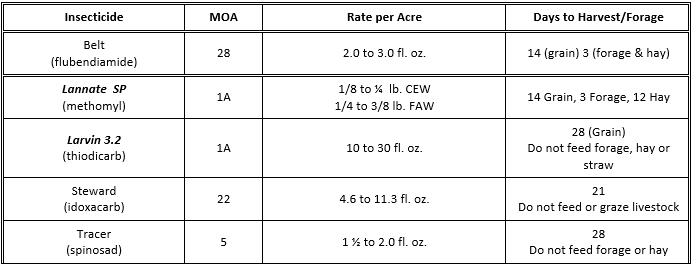
● Corn earworms or fall armyworm infestations should be treated when defoliation levels exceed those listed in Table 2. If pod feeding is occurring, treat when populations reach 2 per row foot. 15” Sweep net treat if 9 or more larvae is found per 25 sweeps
Foliar Treatments for Corn Earworm (=Soybean Podworm) only
(See: Soybean podworm in Kentucky Soybeans. Entfact-144)
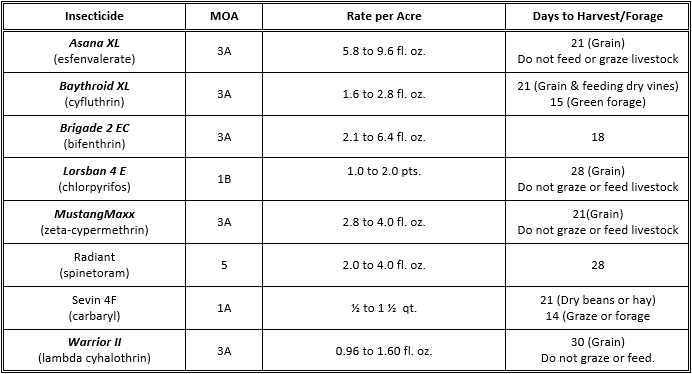
Foliar Treatments for Green Cloverworm, Bean Leaf Beetle, and Mexican Bean Beetle
(See: Bean Leaf Beetle in Kentucky Soybeans. Entfact-131)
(See: Green Cloverworm in Kentucky Soybeans. Entfact-142)
Alternative threshold to 30% defoliation thresholds during pod filling (R1-R5) 15” sweep net.
Bean leaf beetle 50 beetles per 25 sweeps
Green cloverworm 28 larvae per 25 sweeps
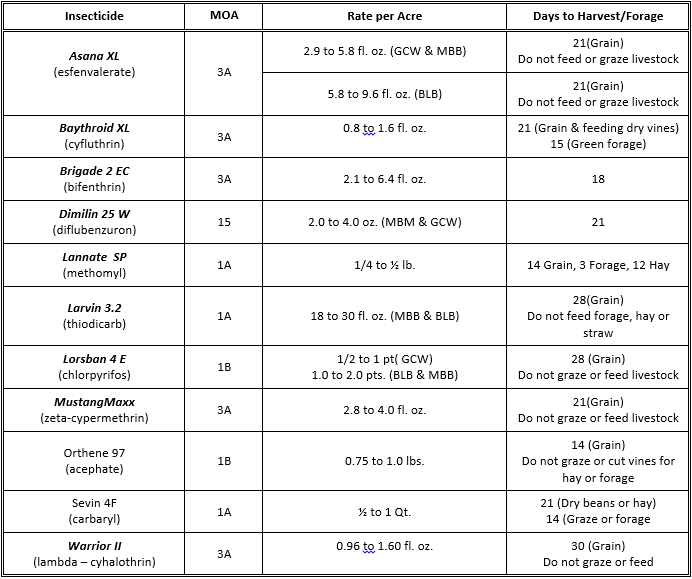
● Fields infested with green cloverworm should be treated when populations exceed those computed from Table 1.
● Treat for Mexican bean beetles according to defoliation guidelines in Table 2 or the population thresholds listed below.
Economic Threshold Table for Mexican Bean Beetles

● Bean leaf beetle damage is estimated by percent defoliation. Use Table 2 to make application decisions.
Foliar Treatments for Green Cloverworm Only
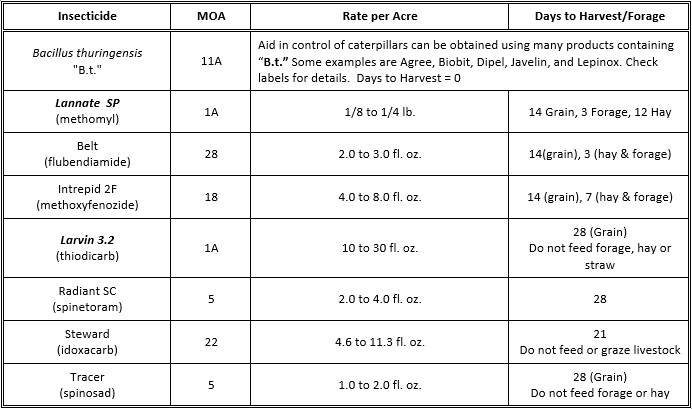
The Bacillus thuringiensis products and Dimilin are "biological insecticides".
Although larval feeding will cease, death may take several days.
Foliar Treatments for Three-cornered Alfalfa Hopper
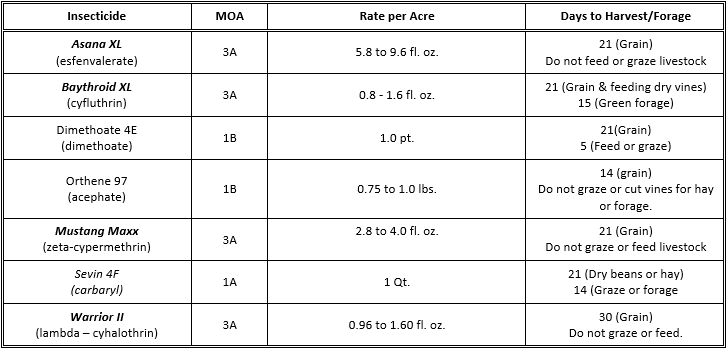
● If 50% of the plants are girdled or if fewer than 4-6 ungirdled plants per row foot remain in conventional rows
(30-40" rows) and three-cornered alfalfa hopper nymphs are still present, controls are recommended.
Foliar Treatments for Grasshoppers
(See: Three Common Kentucky Grasshoppers and their Natural Enemies, Entfact-116)
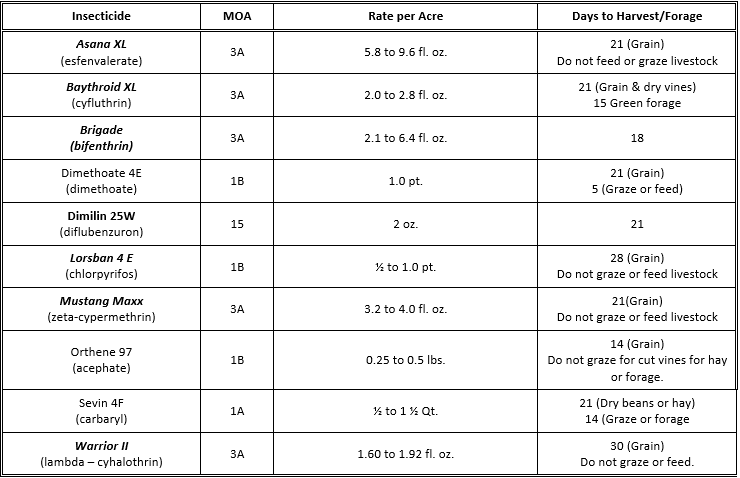
Application of herbicides well in advance of plantings may aid control.
● Treat according to defoliation guidelines in Table 2. ● A field border application is often adequate in conventional beans.
Foliar Treatments for Spider Mites

● This pest is likely only in drought conditions. Treat "bronzed" tissue as defoliation for making control decisions.
Foliar Treatments for Japanese Beetles
(See: Japanese Beetles in Kentucky Soybeans, Entfact-143)
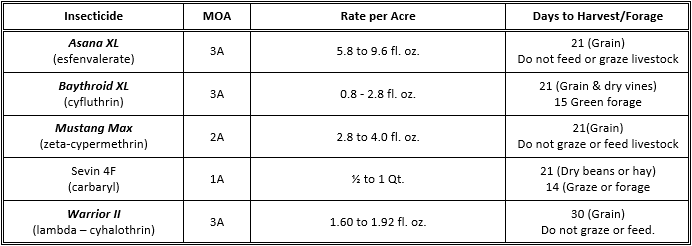
● A field borer application is often adequate in conventional beans. Use Table 2 to decide treatment thresholds.
Foliar Treatments for Soybean Aphid

● Threshold 250 aphids per plant AND 80% of plants infested AND an increasing population AND plant growth stage is R1 (first bloom) through R5 (beginning seed). Threshold for R6 is currently unknown but must be significantly greater than the threshold for R1-R5. Beyond the R6 stage of soybeans, there is no economic return on insecticidal applications for soybean aphid control.
Foliar Treatments for Stink Bugs
Threshold: From beginning bloom (R1) to near maturity (R7): Using a 15” sweep net treat when an average of 9 or more stinkbugs are found in 25 sweeps; or if using a shake cloth on wide rows ,1 stinkbug is found per row foot.
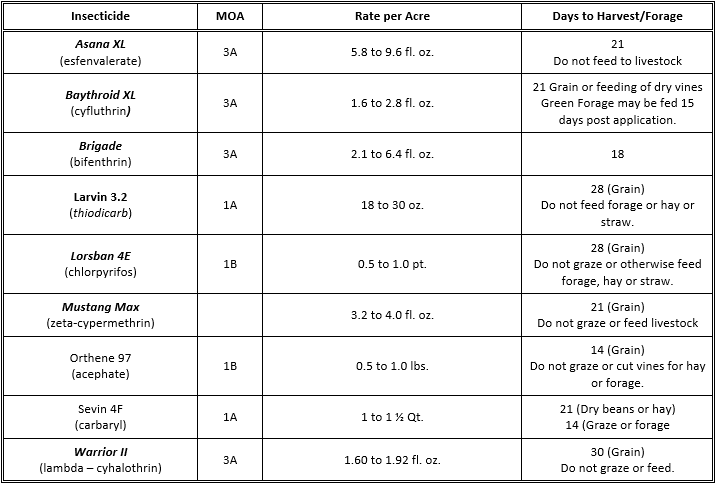
● Nonchemical control: Destroy or utilize crop remnants. Clean weeds from fences, roadsides, ditches, etc. Treat when stink bugs average one per two feet of row, when pods are filling. A field border application may often be adequate.
Products for Control of Insect Pests in Stored Soybean
(See: Controlling Insect in Stored Grain, Entfact-145)
Information in these Tables is subject to change at any time. Always check the label of the product to insure that you use it correctly. There are other brand names and formulations of the products listed below. These are only the most common forms. If you wish to use a similar product check the label to insure it is registered for the intended use.
- “Clean-out” Fumigant
Applied to boots of elevators, beneath false floors etc. This is an “empty” space fumigation targeted at the space beneath the perforated floor in a metal grain bin. Fumigant is applied on a volume not bushel basis. See the WARNING below.
per 1000 cubic feet
Phostoxin, Fumtoxin etc. (aluminum phosphide): tablets 30-140. pellets 150-700
Note: applied to a volume not bushels
Aluminum phosphide is not significantly heavier than air. Because of its light and penetrating nature very close attention must be paid to sealing the area to be treated.
- Empty Bin Surface Applications
per 1,000 ft. sq. of bin surface. Use only in empty bins.
Diacon-D IGR (S-methoprene): 1.5 oz..
Tempo SC Ultra: 0.27 fl. oz.
Insecto, etc. (silicon dioxide, from diatomaceous earth): 1.0 lb.
- Grain Protectants
Applied directly to stored soybean.
Diacon-D IGR (S-methoprene): 8-10 lbs. Per 1,000 bu.
Insecto (Silicon dioxide from diatomaceous earth): 1-2 lbs. per ton
- Grain Surface “Cap Out” Treatments
Applied directly to the top surface of stored soybean for control of Indian Meal Moth.
B.t. products will not control beetles and weevils.
per 1,000 ft sq. (mixed to 4 inches deep)
Biobit HP (Bacillus thuringiensis, kurstaki.): 1 lb. in 5-10 gal.
Dipel DF (Bacillus thuringiensis, kurstaki): 0.5 lb. in 5-10 gal. /
Diacon-D IGR (S-methoprene): 8 lb. (Note: mixed to 12 inches deep)
Indian meal moth adults may be controlled by hanging DDVP Resin strips (Vapona) in the head space over the grain mass. Use 1 strip for each 1,000 cubic feet of air space over the grain. One treatment will last about 3 months.
- Bulk Grain Fumigation
To be applied/1,000 bu. stored soybean.
Phostoxin, Fumetoxin etc. (aluminum phosphide): tablets 40 - 180, pellets 200 - 900
WARNING: Fumigation is a complicated and dangerous technique. If at all possible hire a commercial fumigator. If a commercial fumigation is not possible consult the label of the product you have chosen to use and follow it to the letter. Note that aluminum phosphide labels have undergone major revision in recent years and now contain significant requirements for pre-planning and documentation of the fumigation, and access to considerable safety equipment.
Warning: Insecto and Diacon-D are dust based formulations. Wear a dust mask and protective gloves when handling or applying.
Table 1. The number of GREEN CLOVERWORMS per foot of row that will cause economic injury to soybeans.
Pre-bloom (5 to 6 trifoliates)- treatment recommended when defoliation exceeds 35%.

How to Use These Tables:
Because of the difficulty in determining percentage defoliation, you may prefer to use the tables above for determining approximate economic injury levels of the GREEN CLOVERWORM. First select the table most nearly representing the growth stage of your beans and anticipated yield from the field. Then locate the estimated cost per acre of control (top line) and the estimated value per bushel of your beans (left-hand column). The number found at the point where these lines and columns intersect is the approximate number of GREEN CLOVERWORMS per foot of row that will cause economic injury to soybeans. Do not allow infestations of this insect to exceed this level.
For example, suppose your soybeans are at the stage of early pod-fill, anticipated yield is 35 bushels per acre. Your cost of control is $6 per acre, and the estimated market value of your beans is $8 per bushel. The correct answer is 15 green cloverworms per foot of row.
Table 2. Percent Defoliation Charts for Determining Defoliation Required for Economic Injury to Soybeans
Pre-bloom (5 to 6 trifoliates)-treatment recommended when defoliation exceeds 35 percent.
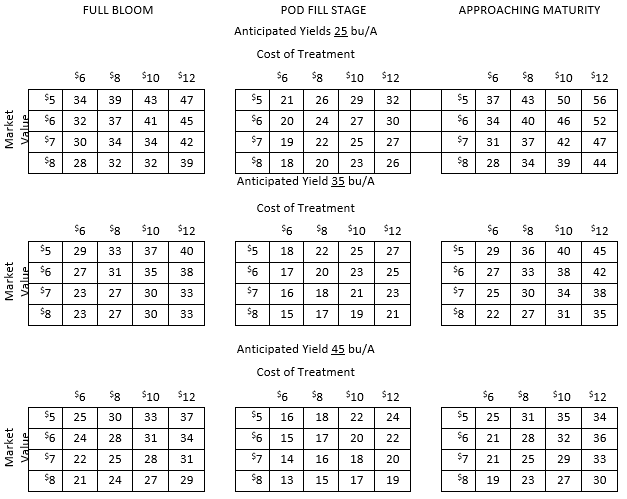
The ability of soybean plants to sustain defoliation without yield reduction varies with the growth of the plant. Under favorable growing conditions the average percent defoliation figures given in this appendix can be used to determine economic injury levels. When the percentage of foliage removed approximates that given in the table for your particular set of variables (cost of treatment, projected yield and projected selling price of beans) treatment should be considered.
For example, if your beans are in bloom stage, you anticipate the yield will be 35 bushels per acre with a selling price of $8.00 per bushel and the cost of treating will be $6.00 per acre, defoliation must be 23 percent or greater to justify treatment.
Educational programs of the Kentucky Cooperative Extension Service serve all people regardless of race, color, age, sex, religion, disability, or national origin.
Issued in furtherance of Cooperative Extension work, Acts of May 8 and June 30, 1914, In cooperation with the U.S. Department of Agriculture. Nancy Cox, Director of Cooperative Extension Service, University of Kentucky College of Agriculture, Lexington, and Kentucky State University, Frankfort.
Revised annually — 11/2015
